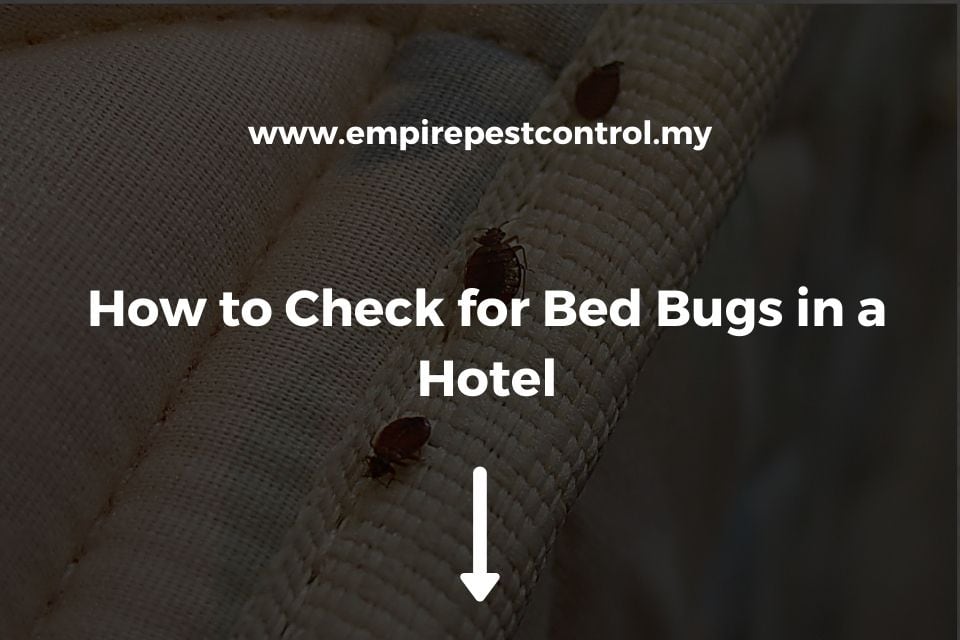Bed bugs can be incredibly distressing. They might cause persistent itching, provoke uncomfortable responses from those nearby, and turn your existence into an absolute nightmare.
With this in mind, hiring a professional bed bug exterminator is often needed for homes to ensure they are safe from these pests.
However, how about hotel rooms?
If you’re worried about bed bugs in hotels or other accommodations, don’t be!
This article will walk through how to check for bedbugs in your hotel room so that you can avoid the pests completely or know if they are there before it’s too late.
Contents
Check The Bed Frame and Mattress For Bed Bug
Just as their name implies, bed bugs can often be found hiding in bed frames and mattresses, waiting for the perfect time to pounce on their prey.
When it comes to hotel rooms, the first thing you need to check is the bed frame and mattress for any signs of these pests.
Luckily, there are a few obvious signs to look out for that will help you identify whether or not they exist in the hotel room; namely, stains from their droppings shed skins or eggs, and small blood spots on linens.
If you spot any of these three things in the hotel bed, you’re in for a very unpleasant stay.
Also, don’t forget to check the headboard and the curtains for the little critters.
It’s best to alert the hotel staff about your findings as soon as possible so that they can eradicate them and make sure no other guests have to suffer through this same experience. For more infomation about hotel pests, you can read this article on common hotel pests in Kuala Lumpur and effective ways to eliminate them.
Inspect Bedside Tables For Bed Bugs
Your bedside table might be infested with a whole swarm of bed bugs without you even knowing. They’re pretty good at hiding.
If you spot any of the aforementioned signs, inspect the bedside tables as well – it’s possible they might be harboring a colony themselves (and that table has been in contact with your sheets and pillow).
You should also look for discoloration on the bedside table since bed bugs often leave fecal spots behind.
Remove the drawers and check for bugs hiding in any crevices – they like to nestle deep inside dark spaces, so don’t be shy about really inspecting every last nook and cranny of your bedside table.
Don’t forget to look under the baseboard near the wall as well – this is often a hiding place for these annoying creatures!
Examine The Wardrobe For Signs of Bed Bugs
One of the places you should never forget to examine when staying in a hotel is the clothes in your wardrobe. Bed bugs can hide inside of clothing, so inspect
The closet or cabinet where you store your clothing can be a good place to look for any signs of bed bugs. These pests will often climb inside your clothes and hide in the folds, so be sure to examine them carefully before packing up your belongings.
If you do find a bug crawling around on one of the garments or hiding deep within a pocket, it’s best not to pack your clothes right away and do a thorough inspection before doing so.
Double-check Sofa and Chair In case of Bed Bugs
If the room you’re staying in has a sofa and chair, then it’s best to check these areas for signs of bed bugs as well, since they are more likely to hide in upholstered furniture than on a wood floor.
To check upholstery furniture, all you need to do is carefully run your fingers along the seams and crease of all cushions.
They can also be found hiding in loose fabric, so make sure to shake out any pillows as well.
And lastly, check for bed bugs underneath the sofa by lifting it up from one end and using a flashlight to check if any critters are running around.
Takeaway
After reading this post, you should be able to inspect for bed bugs in a hotel room and know what signs to look out for.
If you’re not sure about the condition of your hotel mattress or any other furniture, don’t hesitate to ask the front desk or housekeeping staff.
Understanding how these insects behave can help make your stay more comfortable and safe from bites that itch like crazy!
We hope we’ve provided enough information on this topic so that now you can confidently go forth into the pest-ridden world with confidence knowing where they hide and what their telltale signs are.

